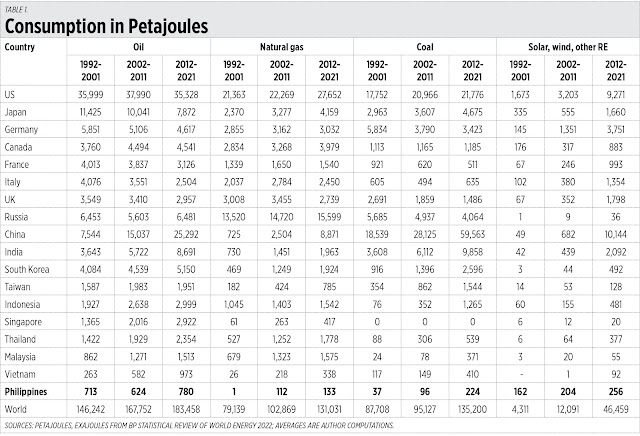No energy transition happening, only RE addition to fossil fuels
* BusinessWorld March 22, 2023.
-----------
The Philippine Electric Power Industry Forum (PEPIF 2023) held this week on March 20 and 21 at the Diamond Hotel — sponsored by the Independent Electricity Market Operator of the Philippines (IEMOP) — was a great success. All the invited speakers came on stage, a few delivered virtual messages, there was a big audience and corporate sponsorships.
BusinessWorld, as media partner of PEPIF 2023, came out with a number of stories. See these four reports by Ashley Erika Jose: “Green energy auction 2nd round due in June” (March 20), “Meralco moves to partly replace lost 670 MW,” “DoE has authority to accelerate charging station rollout — senator” (March 21), and “PSALM says qualified bidders for Casecnan now down to seven” (March 22).
I attended the two-day conference and among the topics that frequently came up or were mentioned by many speakers was “energy transition” from fossil fuels to renewable energy (RE). It was mentioned by Energy Undersecretary Rowena Cristina L. Guevarra, by Energy Regulatory Commission (ERC) Chairperson and CEO Monalisa C. Dimalanta, by Senate President Pro Tempore Loren B. Legarda, and by Senate Committee on Energy Vice-Chairman Sherwin “Win” Gatchalian, other speakers.
Mr. Gatchalian has filed Senate Bill 157 or the “Energy Transition Act” with a specific goal of “net zero emissions by 2050.” This column will try to answer two questions: Is energy transition technologically feasible and happening? and, Is energy transition economically viable and rational?
To help answer the first question, I construct a table covering three decades, 1992-2021. Germany has an energiewende or energy transition program with a specific goal of “a carbon- and nuclear-free energy system by 2045.”
The numbers show the following:
One, all the four European countries in the G7 — Germany, the United Kingdom, France, and Italy — have had deliberate, consistent declines in the consumption of fossil fuels (oil, natural gas, coal) and increases in the share of wind, solar, hydro and other RE over the past three decades.
Two, Japan has had a consistent decline in oil use but increased consumption of gas, coal, and RE. The US has seesawed in oil but continued to rise in the use of gas and coal, plus RE. Canada has had a consistent marginal increase in all three fossil fuels and RE.
Three, China, India, South Korea, Taiwan, and the ASEAN-6 have had consistent increases in use of all three fossil fuels, especially coal, also increased RE use. The world total has been on a similar trend. Singapore has zero coal consumption. (See Table 1).
Next question — Is forced energy transition economically viable and rational?
I built another table covering the same countries over the same three-decade period on their economic growth and price stabilization. The numbers show the following:
One, all the G7 countries have had anemic GDP growth of 2.1% or lower in the last two decades and this is the period when the fast rollout of RE happened. Their inflation rates were no different, if not higher in the last two decades than in the 1990s when RE levels were low.
Two, all the Asian economies listed have had growth of 2.3% to 10.7% in the last two decades when they jacked up their fossil fuel use. Their inflation rates were generally lower in the last two decades compared with rates in the 1990s (See Table 2).
So, looking at two decades worth of data, the answers to the two questions are as follows.
1. Technologically, there is NO energy transition happening in Asia and North America. It does not seem technologically feasible. There is only RE addition on top of high fossil fuel use even among G7 countries. For instance, Germany and the UK’s coal consumption in the last decade were 15 times and seven times larger than the Philippines’. Their respective natural gas consumption were 28 times and 21 times larger than the Philippines’.
2. Economically, energy transition as experienced by the G7 countries is not advisable and rational. It contributed to economic distortion, with low, anemic growth while the prices of commodities remained relatively high.
So, Sen. Win, please drop your bill on energy transition in the Senate. The same move should apply at the House of Representatives, the Department of Energy (DoE), ERC, other government agencies and energy business groups and associations. We should focus on fast, sustained growth. Create more businesses and jobs for Filipinos via the availability of stable and ample electricity, from fossil fuels and RE combined, not restricting one and favoring the other.
A compromise for many people who dislike fossil fuels and yet continue to use lots of fossil fuels is to consider nuclear power.
I attended the breakout session on “Relaunching the nuclear energy program in the Philippines.” Former DoE Undersecretary and now Ateneo Law Professor Cyril del Callar made a really fantastic and objective discussion of the Bataan Nuclear Power Plant (BNPP) which was built in 1976 and should have been running by 1985-86. I support his assessment that what killed BNPP was pure politics and unfounded fear of the technology when it could have been a useful, stable, cheap and safe energy source for the country.
DoE Undersecretary Sharon Garin and Philippine Nuclear Research Institute Deputy Director Vallerie Ann Samson also gave good, objective assessments on the potential contribution of nuclear power.
Federation of Philippine Industries Chairman Jesus L. Arranza gave a consumer point of view on energy issues. At the sideline, I asked him if he had big resources as a genco, what would he do. He replied that he would prioritize the island provinces, build more power plants there to attract more investments, businesses, and jobs. I support his simple but rational assessment.






Comments
Post a Comment